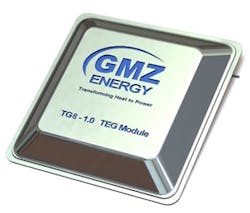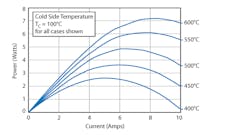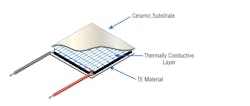A thermoelectric generator, TEG, is a solid-state device that converts heat directly into electrical energy through a phenomenon called the Seebeck effect. Thermoelectric generators consist of three major components: thermoelectric materials, thermoelectric modules, and thermoelectric systems that interface with the heat source.
Thermoelectric materials generate power directly from heat by converting temperature differences into a dc voltage. To be good thermoelectric materials these materials must have both high electrical conductivity and low thermal conductivity. Having low thermal conductivity ensures that when one side is made hot, the other side stays cold, which helps to generate a large voltage while in a temperature gradient.
The typical efficiency of TEGs is around 5% to 8%. Older devices used bimetallic junctions and were bulky. More recent devices use highly doped semiconductors made from bismuth telluride(Bi2Te3), lead telluride (PbTe), calcium manganese oxide (Ca2Mn3O8), or combinations thereof, depending on temperature. Maximizing the efficiency (or, conversely, the total power output) of requires trade-offs between total heat flow through the thermoelectric modules and maximizing the temperature gradient across them. The design of heat-exchanger technologies to accomplish this is one of the most important aspects of engineering of a thermoelectric generator.
Three semiconductors are known to have both low thermal conductivity and high power factor:
• Low temperature materials (up to around 450K): alloys based on Bismuth (Bi) in combinations with Antimony (Sb), Tellurium (Te), or Selenium (Se).
• Intermediate temperature (up to 850K): such as materials based on alloys of Lead (Pb).
• Highest-temperatures material (up to 1300K): materials fabricated from silicon germanium (SiGe) alloys.
Although these materials still remain the cornerstone for commercial and practical applications in thermoelectric power generation, significant advances have been made in synthesizing new materials and fabricating material structures with improved thermoelectric performance. Recent research has focused on improving the material’s figure-of-merit (zT), and hence the conversion efficiency, by reducing the lattice thermal conductivity.
Researchers are trying to develop new thermoelectric materials for power generation by improving the figure-of-merit zT. One example of these materials is the semiconductor compound ß-Zn4Sb3, which possesses an exceptionally low thermal conductivity and exhibits a maximum zT of 1.3 at a temperature of 670K. This material is also relatively inexpensive and stable up to this temperature in a vacuum, and can be a good alternative in the temperature range between materials based on Bi2Te3 and PbTe.
Besides improving the figure-of-merit, there is increasing focus to develop new materials by increasing the electrical power output, decreasing cost and developing environmentally friendly materials. For example, when the fuel cost is low or almost free, such as in waste-heat recovery, then the cost per watt is only determined by the power per unit area and the operating period. As a result, it has initiated a search for materials with high power output rather than conversion efficiency. For example, the rare earth compound YbAl3 has a low figure-of-merit, but it has a power output of at least double that of any other material, and can operate over the temperature range of a waste-heat source.
Many challenges are confronted when designing a reliable TEG system that operates at high temperatures. Achieving high efficiency in the system requires extensive engineering design in order to balance between the heat flow through the modules and maximizing the temperature gradient across them. To do this, designing heat-exchanger technologies in the system is one of the most important aspects of TEG engineering. In addition, the system must minimize the thermal losses due to the interfaces between materials at several places. Another challenging constraint is avoiding large pressure drops between the heating and cooling sources.
When selecting materials for thermoelectric generation, a number of other factors need to be considered. During operation, ideally the thermoelectric generator has a large temperature gradient across it. Thermal expansion will then introduce stress in the device, which may cause fracture of the thermoelectric legs, or separation from the coupling material. The mechanical properties of the materials must be considered and the coefficient of thermal expansion of the n- and p-type material must be matched reasonably well.
Thermoelectric generators can be applied in a variety of applications. Frequently, thermoelectric generators are used for low-power remote applications or where bulkier but more efficient heat engines such as Stirling engines would not be possible. Unlike heat engines, the solid-state electrical components typically used to perform thermal to electric energy conversion have no moving parts. The thermal to electric energy conversion can be performed using components that require no maintenance, have inherently high reliability, and can be used to construct generators with long service-free lifetimes. This makes thermoelectric generators well suited for equipment with low to modest power needs in remote uninhabited or inaccessible locations such as mountaintops, the vacuum of space, or the deep ocean.
Besides low efficiency and high cost, two general problems exist in such devices: high output resistance and adverse thermal characteristics.
• High output resistance. In order to get a significant output voltage, a very high Seebeck coefficient is needed (high V/°C). A common approach is to place many thermo-elements in series, causing the effective output resistance of a generator to be very high (>10Ω). Thus, power is only efficiently transferred to loads with high resistance; power is otherwise lost across the output resistance. This problem is solved in some commercial devices by putting more elements in parallel and fewer in series.
• Adverse thermal characteristics. Because low thermal conductivity is required for a good thermoelectric generator, this can severely dampen the heat dissipation of such a device (i.e., thermoelectric generators serve as poor heat sinks). They are only economical when a high temperature (>200 °C) can be used and when only small amounts of power (a few watts) are needed.
Most thermoelectric generator module manufacturing companies use many thermoelectric couples that are sandwiched between two pieces of non-electrically conductive materials. It is also necessary for this material to be thermally conductive to ensure a good heat transfer; usually two thin ceramic wafers are used to form what is called a “thermoelectric module.”
Each module can contain dozens of pairs of thermoelectric couples called thermoelectric generator modules, TEC modules, and sometimes Peltier or Seebeck modules, which simply denotes whether they are being used to generate electricity (Seebeck) or produce heat or cold (Peltier). Functionally there is no difference between the two. They both are capable of producing heat and cold or generating electricity, depending on whether heat is applied or an electrical current.
There are differences in performance between various modules depending on what they were manufactured for. For example, if a module is being manufactured for use in a 12-volt dc automotive cooler, the thermoelectric couples will be of a thicker gauge and so will the wire connecting the modules to the 12-volt dc power source. In most cases, the module itself is quite large. This is simply because the module will be conducting a heavy load of current and will need to be able to handle the load. Although these type modules can be used to produce electricity, they are not well suited for the task because they have a high internal resistance (lowering output) and lower temperature solder that may melt if used for Seebeck purposes. This means the electrical connection may fail when the higher heat needed to produce significant amounts of electricity is applied to the module.
GMZ-Energy
GMZ-Energy’s TG16-1.0 thermoelectric module is capable of producing twice the power of the company’s first product, the TG8 (Fig. 21-1). The highly efficient TG16-1.0 directly converts waste heat into usable electricity and is well suited for extremely high-temperature environments, such as those in boilers and furnaces.
21-1. TG8-1.0 Thermoelectric Module from GMZ.
By doubling the power density, GMZ’s new module substantially increases performance while maintaining a minimal footprint. The TG16-1.0 will augment the TG8, enabling dramatic efficiency improvements and new functionalities in products requiring high power density. Now, with two product offerings, GMZ is capable of providing a solution to even more OEM partners around the world.
GMZ Energy’s proprietary platform technology enables low-cost manufacturing of bulk thermoelectric materials. The company’s patented nano-structuring process reduces thermal conductivity while maintaining electrical conductivity, enhancing the performance (“figure of merit,” zT) by 30% to 60% across multiple classes of thermoelectric materials, including bismuth telluride, lead telluride, skutterudites, silicon germanium, and half-Heusler materials.
The company has recently applied its nano-structuring process to half-Heusler materials, yielding a unique combination of high performance, high strength and low cost. GMZ’s proprietary method of bulk manufacturing TE materials of less than 1 micron in size is more cost-effective than known nanowire or thin-film manufacturing methods for temperatures of 550°C to 650°C on the hot side and 100°C on the cold side.
A demonstration of the TEG’s ability to convert a vehicle’s waste heat into electricity was performed for the Army’s TARDEC (Tank Automotive Research, Development and Engineering Center) program. For that program, GMZ Energy successfully demonstrated a 1,000W TEG designed for diesel engine exhaust heat recapture. The company integrated five 200W TEGs into a single 1,000W diesel engine solution that directly converts exhaust waste heat into electrical energy, which increases fuel efficiency and lowers overall costs.
The GMZ TEGs demonstrated continuous output power with no degradation in performance over the test period. To simulate vehicle performance, the unit was tested by connecting directly to the exhaust of a 15-liter V8 diesel engine inside an engine test cell. At approximately 80 liters (2.8 ft3), GMZ’s TEG was less than one-third of the TARDEC program’s specified size requirement.
The operating temperature range of a TEG depends on the materials employed. For example, a bismuth-tellurium system is suitable for relatively low temperature operation (room temperature to 200 °C), whereas silicon-germanium alloys work best for high-temperature applications (>800°C). For moderate temperature (T = 500°C to 800°C) heat sources such as a vehicle’s exhaust and industrial waste heat, half-Heusler types are the material of choice.
The GMZ TEGs demonstrated continuous output power with no degradation in performance over the test period. To simulate vehicle performance, the unit was tested by connecting directly to the exhaust of a 15-liter V8 diesel engine inside an engine test cell. At approximately 80 liters (2.8 ft3), GMZ’s TEG was less than one-third of the TARDEC program’s specified size requirement.
With this demonstration, GMZ successfully reached an important milestone in the $1.5 million vehicle-efficiency program sponsored by TARDEC and administered by the U.S. Department of Energy (DOE). With battlefield fuel costs ranging from $40 to $800 per gallon, the U.S. military is especially interested in thermoelectric technologies, which are physically robust, have long service lives, and require no maintenance due to their solid-state design.
GMZ’s patented half-Heusler material is uniquely well suited for military applications. The 1000W TEG features enhanced mechanical integrity and high-temperature stability thanks to a patented nano-structuring approach. GMZ’s TEG also enables silent generation, muffles engine noise, and reduces thermal structure. Half-Heusler is environmentally friendly and mechanically and thermally robust, although cost may be an eventual issue.
The TARDEC TEG incorporates GMZ’s TG8-1.0 modules, which are the first commercially available modules capable of delivering power densities greater than one Watt/cm² while operating at 600°C. Fig. 21-2 shows the power output of a TG8-1.0 module as a function of current and temperature. The TARDEC 1000W TEG consists of 400 TG8-1.0 modules with associated cold-side and hot-side heat exchangers and manifolds. GMZ did the engineering and CFD simulation to project performance. The technology’s uniqueness is its ability to operate at high-temperature gradients (high ∆T), which allows the extraction of more power per unit area of the TEG modules.
21-2. TG8-1.0 power output as a function of temperature and output current.
The next phase of this program will be testing in a Bradley Fighting Vehicle. Besides saving money and adding silent-power functionality for the U.S. military, this TEG can increase fuel efficiency for most gasoline and diesel engines. This low-cost TEG technology fits into a broad array of commercial markets, including long-haul trucking, heavy equipment, and light automotive.
Due to the high currents involved, GMZ usually employs series connections to maximize voltage and minimize current as much as possible as well as to minimize I2R losses. Because diesel exhaust is less than 600°C and the module hot-side temperature is even lower than the flow temperature, the modules do not give their full power output the way they do in other applications. However, even with the derating to account for the lower hot-side temperature, the economics of incorporating these systems is very compelling with payback times typically less than 12 to 24 months.
A high ∆T capability can result in higher efficiency in some cases. However, what really matters is the $/Watt. When the input energy is free, the cost of the output energy is driven entirely by the cost of the generator. GMZ designed the system to minimize the $/W in order to maximize their utility to the largest possible set of prospective users. Because any thermoelectric material generates more power with higher ∆T, GMZ focused on half-Heusler material systems, which have very high temperature capability. GMZ modules are rated for 600°C continuous hot-side capability with 700°C intermittent. This maximizes power per device, which minimizes the $/W. In volume production, GMZ expects its TEG systems to be below $1/W.
GMZ Energy’s proprietary platform technology enables low-cost manufacturing of bulk thermoelectric materials. The company’s nano-structuring process reduces thermal conductivity while maintaining electrical conductivity, enhancing the performance (figure of merit, zT) by 30% to 60% across multiple classes of thermoelectric materials, including bismuth telluride, lead telluride, skutterudites, silicon germanium, and half-Heusler materials.
Compared to thin-film and nanowire materials, GMZ’s nano-structured bulk materials have superior mechanical integrity and high-temperature (20°C-800°C) thermal stability. GMZ’s TEG materials and processes also allow direct bonding to interconnect without the need for metallization, which lowers costs and increases module durability and life cycle. This enables the module to provide consistent energy over long-term cycling, even in the most challenging environments.
The 1000W TEG is composed of 400 TG8 modules with associated cold-side and hot-side heat exchangers and manifolds. GMZ did the engineering and CFD simulation to project the performance. GMZ’s uniqueness is its ability to operate at high-temperature gradients (high ∆T), which allows the extraction of more power unit area of its TE modules.
The 1000W test unit included 400 modules. In general, GMZ tries to do series connections (maximize voltage and minimize current) as much as possible in order to minimize I2R losses due to the high currents involved. Because diesel exhaust is less than 600°C and the module hot-side temperature is even lower than the flow temperature, the modules do not give their full power output the way they do in applications like self-powered boilers. However, even with the derating to account for the lower hot-side temperature, the economics of incorporating these systems is very compelling with payback times typically less than 12 to 24 months.
High ∆T capability of the TG8-1.0 can result in higher efficiency in some cases. However, what really matters is the $/Watt. When the input energy is free, the cost of the output energy is driven entirely by the cost of the generator. The system is designed to minimize the $/W in order to maximize the largest possible set of prospective users. Because any thermoelectric material generates more power with higher ∆T, GMZ has focused on half-Heusler material systems that have very high temperature capability. Modules are rated for 600°C continuous hot-side capability with 700°C intermittent. This maximizes the power per device and minimizes $/W. In volume production, GMZ expects to sell its TEG systems at or below $1/W.
Test and Measurement
In certain applications, thermoelectric modules (TEMs) are typically used to achieve the rapid temperature changes. The advantages of thermoelectric modules over other types of thermal cycling devices are precise temperature control, compactness, faster temperature ramp rates, and efficiency.
The PC Series TEMs from Laird are proven to perform for more than 800,000 temperature cycles and can operate in temperatures up to 120°C. This exceeds the requirements for certain applications and provides a lower total cost of ownership.
These TEMs are constructed with multiple layers between the ceramic substrates, copper buss bars, and semiconductor couples (Fig. 21-3). To reduce thermally induced stress, a flexible and thermally conductive “soft layer” is inserted between the cold-side ceramic substrate and copper buss bars. The integration of the polymer into the thermoelectric modules absorbs the mechanically induced stresses caused by rapid temperature cycling. As a result, the stress induced on the semiconductor couples and solder joints is significantly reduced, extending the overall operational life of TEM.
21-3. Laird’s PCS series of thermoelectric modules are intended for thermal cycling applications.
Thermal cycling exposes TEMs to mechanical stresses as the module contracts and expands from repeated cooling and heating cycles. The high-temperature diffusion of impurities and mechanical stresses over time significantly reduces the operational life of a standard TEM. The PC Series is designed to handle hundreds of thousands of thermal cycles with minimal degradation.
Among its features:
• Designed to pass rigorous testing
• Robust construction developed for thermal cycling applications
• 800K+ thermal-cycle operating life
• Superior temperature control stability
• RoHS compliant
About the Author

Sam Davis
Sam Davis was the editor-in-chief of Power Electronics Technology magazine and website that is now part of Electronic Design. He has 18 years experience in electronic engineering design and management, six years in public relations and 25 years as a trade press editor. He holds a BSEE from Case-Western Reserve University, and did graduate work at the same school and UCLA. Sam was the editor for PCIM, the predecessor to Power Electronics Technology, from 1984 to 2004. His engineering experience includes circuit and system design for Litton Systems, Bunker-Ramo, Rocketdyne, and Clevite Corporation.. Design tasks included analog circuits, display systems, power supplies, underwater ordnance systems, and test systems. He also served as a program manager for a Litton Systems Navy program.
Sam is the author of Computer Data Displays, a book published by Prentice-Hall in the U.S. and Japan in 1969. He is also a recipient of the Jesse Neal Award for trade press editorial excellence, and has one patent for naval ship construction that simplifies electronic system integration.
You can also check out his Power Electronics blog.



